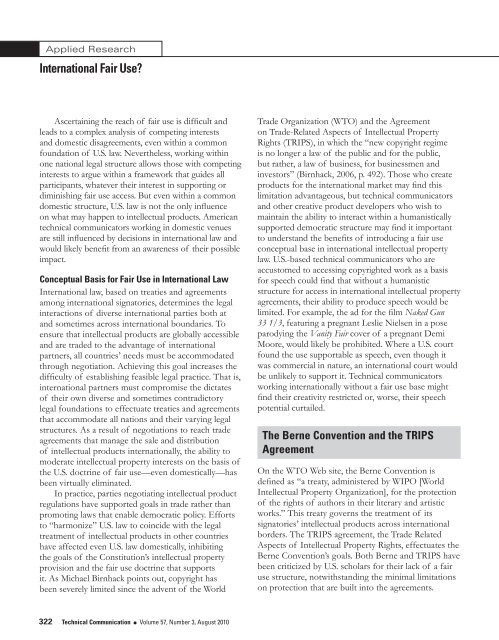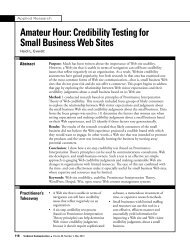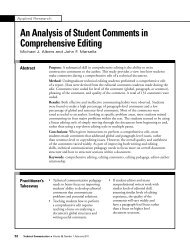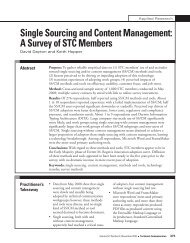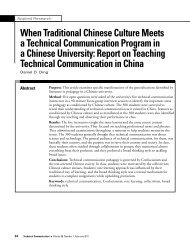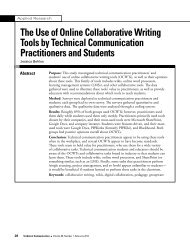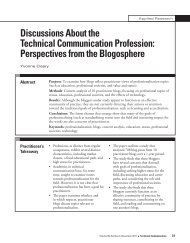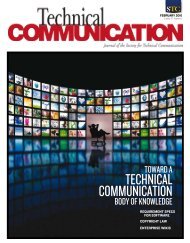Applied ResearchInternational Fair Use?Ascertaining the reach of fair use is difficult andleads to a complex analysis of competing interestsand domestic disagreements, even within a commonfoundation of U.S. law. Nevertheless, working withinone national legal structure allows those with competinginterests to argue within a framework that guides allparticipants, whatever their interest in supporting ordiminishing fair use access. But even within a commondomestic structure, U.S. law is not the only influenceon what may happen to intellectual products. Americantechnical communicators working in domestic venuesare still influenced by decisions in international law andwould likely benefit from an awareness of their possibleimpact.Conceptual Basis for Fair Use in International LawInternational law, based on treaties and agreementsamong international signatories, determines the legalinteractions of diverse international parties both atand sometimes across international boundaries. Toensure that intellectual products are globally accessibleand are traded to the advantage of internationalpartners, all countries’ needs must be accommodatedthrough negotiation. Achieving this goal increases thedifficulty of establishing feasible legal practice. That is,international partners must compromise the dictatesof their own diverse and sometimes contradictorylegal foundations to effectuate treaties and agreementsthat accommodate all nations and their varying legalstructures. As a result of negotiations to reach tradeagreements that manage the sale and distributionof intellectual products internationally, the ability tomoderate intellectual property interests on the basis ofthe U.S. doctrine of fair use—even domestically—hasbeen virtually eliminated.In practice, parties negotiating intellectual productregulations have supported goals in trade rather thanpromoting laws that enable democratic policy. Effortsto “harmonize” U.S. law to coincide with the legaltreatment of intellectual products in other countrieshave affected even U.S. law domestically, inhibitingthe goals of the Constitution’s intellectual propertyprovision and the fair use doctrine that supportsit. As Michael Birnhack points out, copyright hasbeen severely limited since the advent of the WorldTrade Organization (WTO) and the Agreementon Trade-Related Aspects of Intellectual PropertyRights (TRIPS), in which the “new copyright regimeis no longer a law of the public and for the public,but rather, a law of business, for businessmen andinvestors” (Birnhack, 2006, p. 492). Those who createproducts for the international market may find thislimitation advantageous, but technical communicatorsand other creative product developers who wish tomaintain the ability to interact within a humanisticallysupported democratic structure may find it importantto understand the benefits of introducing a fair useconceptual base in international intellectual propertylaw. U.S.-based technical communicators who areaccustomed to accessing copyrighted work as a basisfor speech could find that without a humanisticstructure for access in international intellectual propertyagreements, their ability to produce speech would belimited. For example, the ad for the film Naked Gun33 1/3, featuring a pregnant Leslie Nielsen in a poseparodying the Vanity Fair cover of a pregnant DemiMoore, would likely be prohibited. Where a U.S. courtfound the use supportable as speech, even though itwas commercial in nature, an international court wouldbe unlikely to support it. Technical communicatorsworking internationally without a fair use base mightfind their creativity restricted or, worse, their speechpotential curtailed.The Berne Convention and the TRIPSAgreementOn the WTO Web site, the Berne Convention isdefined as “a treaty, administered by WIPO [WorldIntellectual Property Organization], for the protectionof the rights of authors in their literary and artisticworks.” This treaty governs the treatment of itssignatories’ intellectual products across internationalborders. The TRIPS agreement, the Trade RelatedAspects of Intellectual Property Rights, effectuates theBerne Convention’s goals. Both Berne and TRIPS havebeen criticized by U.S. scholars for their lack of a fairuse structure, notwithstanding the minimal limitationson protection that are built into the agreements.322 Technical Communication l Volume 57, Number 3, August 2010
Applied ResearchTyAnna K. HerringtonIn the Berne Convention, some exceptions tointellectual product protection exist to allow supportfor teaching and news reporting, but these exceptionsfunction minimally and, according to most scholars,leave concerns for access to domestic legislationbecause “Berne and WIPO were created in orderto protect the economic rights of owners, not theaccess rights of users” (Foster, 2008, p. 199). So,for example, technical communicators would behindered from accessing others’ products for reverseengineering, which would otherwise be supportedby U.S. copyright law. Foster notes that it is nosurprise that Berne’s primary function is to protectthe economic rights of copyright holders, because itsdevelopment was a result of “authors’ rights groupsexerting political pressure on their governments inorder to obtain protection on an international level”(Foster, 2008, p. 196). Nevertheless, some concessionswere made to access, acknowledging the need topreserve public access to important information.Thus, Berne allows limited access to works of ascientific or educational nature (Foster, 2008, p. 196).The existence of these exceptions indicates that theinternational community recognizes a need for someform of access to information on the basis of publicnecessity. But many authors believe that the TRIPSagreement that effectuates Berne is too limited in itssupport of public access.TRIPS Trade-Related Aspects ofIntellectual Property RightsThe TRIPS agreement sets standards for treatingintellectual products that emphasize intellectualproduct protection. Rochelle Dreyfuss notes thatbecause the motivation for the TRIPS agreement wasto protect intellectual products and encourage trade,it did little to aid users’ rights of access (Dreyfuss,2004, p. 21). And although Richard Peltz (2009) arguesthat fair use actions are creeping into the activitiessurrounding treatment of intellectual property underBerne and TRIPS, Ruth Okediji, an oft-cited authorwho proposes a new fair use resolution, makes a strongcase that they are not. She says, “One of the cardinalobjectives of TRIPS, then, was to extend strongintellectual property rules to the rest of the world inan attempt to redeem maximum value for intellectualproperty products in the global market” (Okediji, 2000,p. 81). She says this was necessary to “redress theproblem of lax enforcement and to secure the basisof competition in the global information economy”(p. 81). In fact, as she points out, among many whowork with international intellectual property law, “theAgreement has earned notoriety as the most ambitiousinternational accord on the protection of intellectualproperty” (p. 81).This strict protectionist mantle characterizesinternational intellectual property law partiallybecause intellectual property treaties are created morein consideration of patent than copyright, and nofair use access is provided in patent law, even in theUnited States. In addition, the business structures ofparties who develop patents are often very differentfrom those of the people who work with copyrights,trademarks, and trade secrets. Where patents are usuallydeveloped by large corporate entities, copyrights maybe created by individuals; significantly, the economicinterests of those who patent and those who copyrightcan vary broadly.Implications for Technical CommunicatorsTechnical communicators populate vastly differingworkplace venues; some may develop products forlarge companies whose main interest is in protectingpatents, while others may run individually owned andoperated small businesses that compete by developingunique products to introduce to an established market.Academics in technical communication have an interestin accessing intellectual products as a way to assesstheir impact on society or their potential to shapetrends in business and communication development.A strong protectionist base in international trade lawultimately provides substantial aid to those with greatpower and can hinder access for those who lack power.Technical communicators, thus, are affected by theparameters of their specific workplaces as well as bythe international intellectual property law in each venuein which they work.Product developers who are interested in humanisticaccess to information to support learning andVolume 57, Number 3, August 2010 l Technical Communication 323
- Page 1 and 2:
AUGUST 2010Volume 57 Number 3SPECIA
- Page 3 and 4:
PresidentMichael A. HughesVice Pres
- Page 5 and 6:
VoLuME 57, NuMBER 3AUGUST 2010ISSN
- Page 7 and 8:
Guest EditorialKirk St.Amant and Ma
- Page 9 and 10:
Applied ResearchTechnical Communica
- Page 11 and 12:
Applied ResearchNicole St. Germaine
- Page 13 and 14:
Applied ResearchNicole St. Germaine
- Page 15 and 16:
Applied ResearchNicole St. Germaine
- Page 17 and 18:
Applied ResearchNicole St. Germaine
- Page 19 and 20:
Applied ResearchNicole St. Germaine
- Page 21 and 22:
Applied ResearchNicole St. Germaine
- Page 23 and 24:
Applied ResearchNicole St. Germaine
- Page 25 and 26:
Applied TheoryTatiana BatovaIntrodu
- Page 27 and 28:
Applied TheoryTatiana BatovaMoreno,
- Page 29 and 30: Applied TheoryTatiana BatovaThe Uni
- Page 31 and 32: Applied TheoryTatiana Batovadoctors
- Page 33 and 34: Applied TheoryTatiana BatovaTo addr
- Page 35 and 36: Applied TheoryTatiana Batovathe loc
- Page 37 and 38: Applied TheoryTatiana BatovaJohnson
- Page 39 and 40: Applied TheoryTatiana BatovaInterna
- Page 41 and 42: Applied TheoryMcKee and PorterIntro
- Page 43 and 44: Applied TheoryMcKee and PorterFor e
- Page 45 and 46: Applied TheoryMcKee and Porterpubli
- Page 47 and 48: Applied TheoryMcKee and PorterBecau
- Page 49 and 50: Applied TheoryMcKee and Porterof th
- Page 51 and 52: Applied TheoryMcKee and Porterwith
- Page 53 and 54: Applied TheoryMcKee and PorterA Cop
- Page 55 and 56: Applied TheoryMcKee and PorterConte
- Page 57 and 58: Applied TheoryMcKee and PorterWalto
- Page 59 and 60: Applied ResearchLiza PottsIntroduct
- Page 61 and 62: Applied ResearchLiza Pottsdoes not
- Page 63 and 64: Applied ResearchLiza PottsUser’s
- Page 65 and 66: Applied ResearchLiza Pottsactors, t
- Page 67 and 68: Applied ResearchLiza PottsDRM has a
- Page 69 and 70: Applied ResearchLiza Pottsmake bett
- Page 71 and 72: Applied ResearchLiza PottsOne viewe
- Page 73 and 74: Applied ResearchLiza Pottsinvolved
- Page 75 and 76: Applied ResearchLiza PottsHayhoe, G
- Page 77 and 78: Applied ResearchInternational Fair
- Page 79: Applied ResearchTyAnna K. Herringto
- Page 83 and 84: Applied ResearchTyAnna K. Herringto
- Page 85 and 86: Applied ResearchTyAnna K. Herringto
- Page 87 and 88: Applied ResearchTyAnna K. Herringto
- Page 89 and 90: Book ReviewsWriting Successful Scie
- Page 91 and 92: Book ReviewsThe Process: Business P
- Page 93 and 94: Book ReviewsHCI Beyond the GUI: Des
- Page 95 and 96: Book ReviewsOrigins of the Specious
- Page 97 and 98: Book Reviewsgenre, and process, top
- Page 99 and 100: Book ReviewsPart One goes from the
- Page 101 and 102: Book Reviewsrather than writers, an
- Page 103 and 104: Book ReviewsHow to Write Fast Under
- Page 105 and 106: Book Reviewsmanagement system (CMS)
- Page 107 and 108: Book Reviewsnearly strangled when h
- Page 109 and 110: Book Reviewsinteractive TV model)
- Page 111 and 112: Book ReviewsOtherwise, Beech shows
- Page 113 and 114: Book Reviewssuch as blog, I found m
- Page 115 and 116: Book Reviewsemployees and effective
- Page 117 and 118: Recent & RelevantSherry Southard, E
- Page 119 and 120: Recent & RelevantRecent & RelevantC
- Page 121 and 122: Recent & RelevantRecent & RelevantE
- Page 123 and 124: Recent & Relevantworking in a langu
- Page 125 and 126: Recent & RelevantWhat’s the big d
- Page 127 and 128: Recent & RelevantScientific Writing
- Page 129 and 130: Recent & Relevantapplicability. Man
- Page 131:
Did You Missthe Summit?Don’t miss


